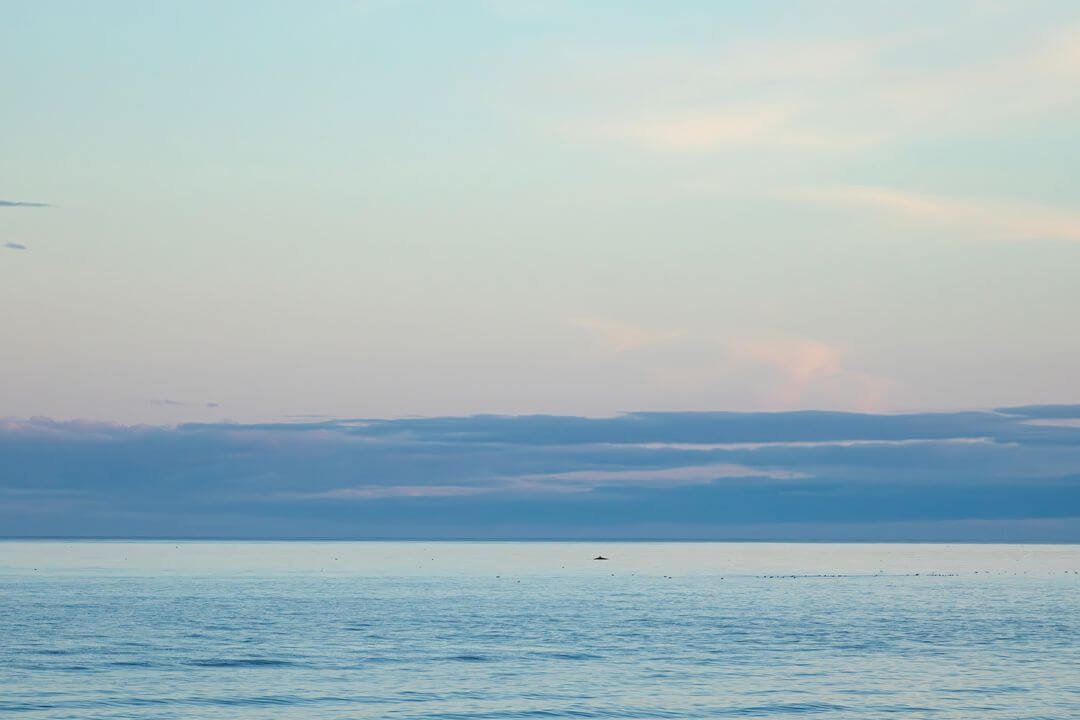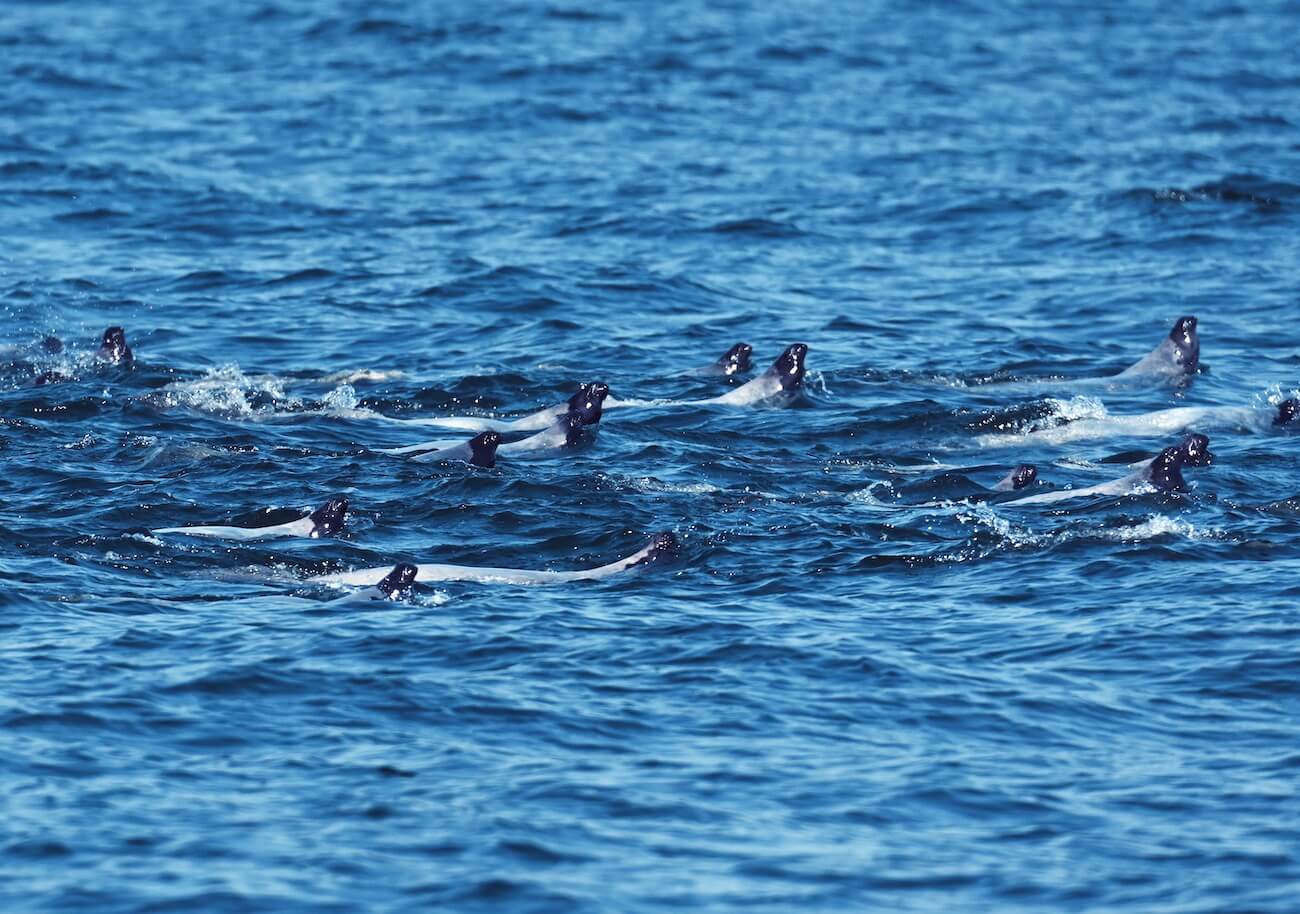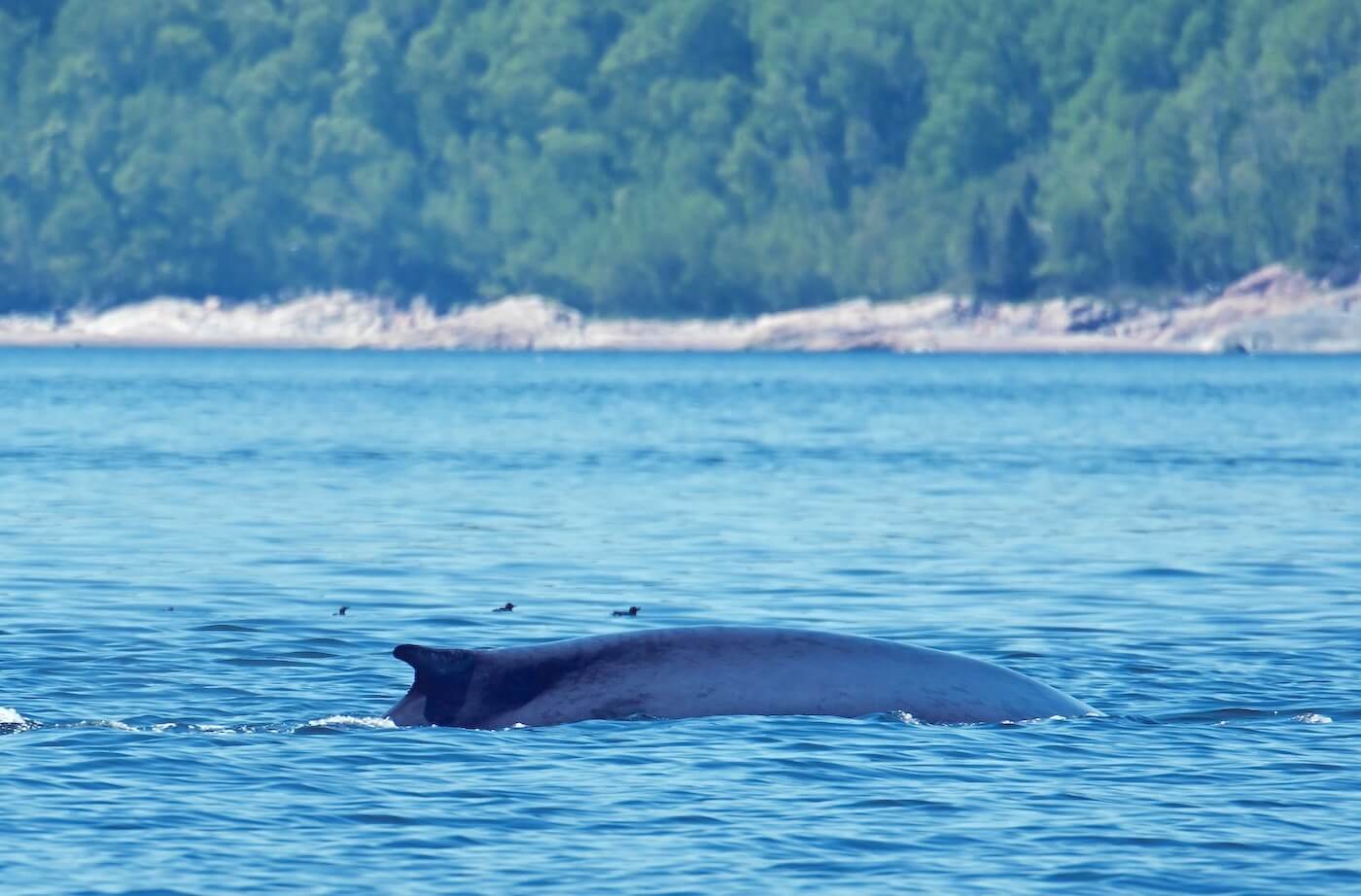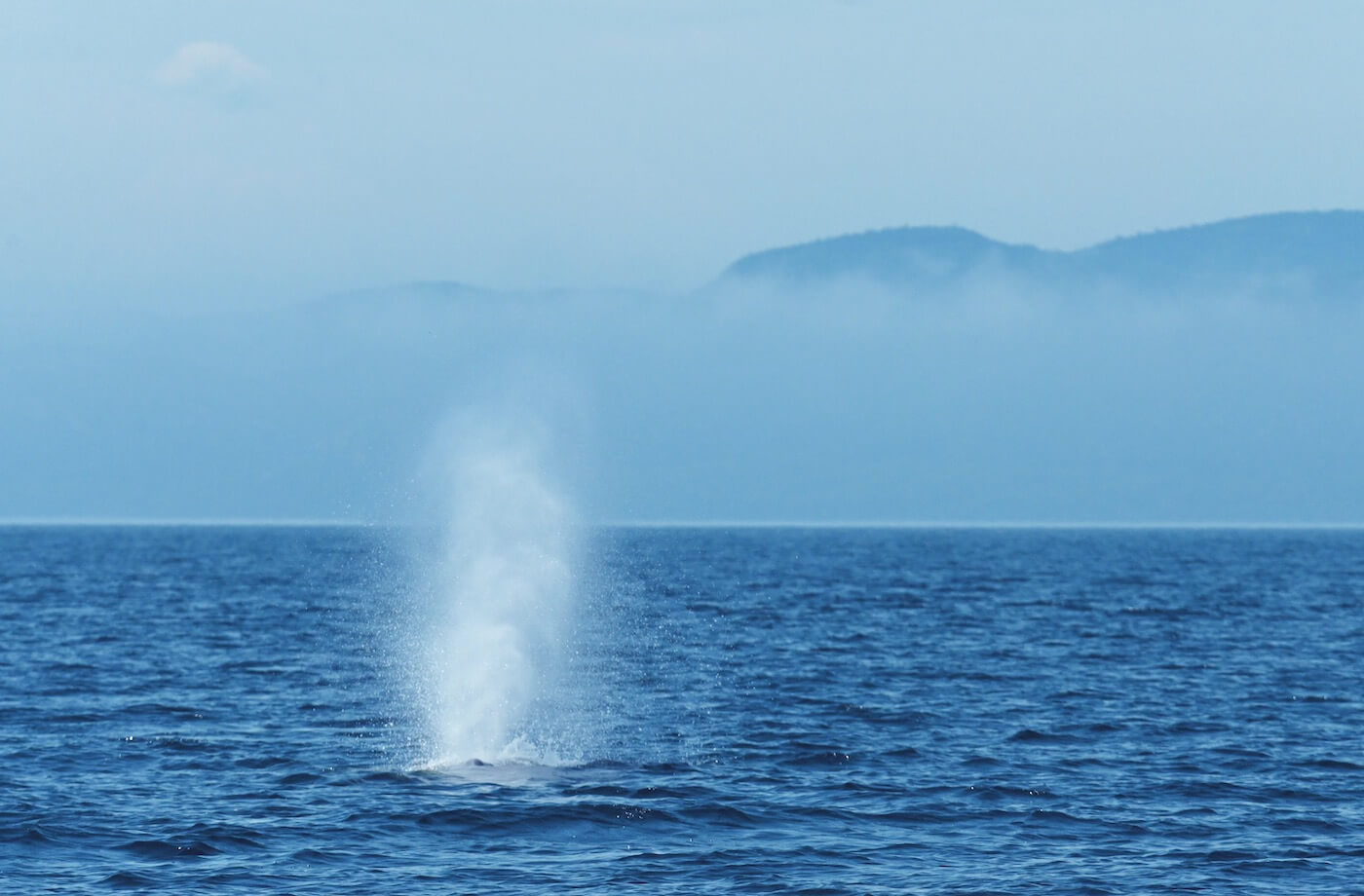Whether they consume krill, fish or invertebrates, whales come to feed in the St. Lawrence and the immense smörgåsbord it represents. From the great blue whale in the Saguenay-St. Lawrence Marine Park to the smallest porpoise in Sept-Îles, marine mammals are devouring their meals and regaining strength after their long migrations. Nearly everywhere, minke whales perform impressive feats to take the largest bites possible, while in Gaspésie a humpback whale feeds on the surface, showing off its baleen.
Surface feeding humpbacks in Gaspésie
In Gaspésie, this year’s whale-watching season began with a bang: “We’ve been spoiled since the start of the season,” comments one regular observer. It’s a beautiful day, with almost no wind. There are two fin whales that we’ve been seeing regularly and many minke whales. This morning, five humpbacks were spotted.” He also had the chance to see a humpback feeding near the surface. This behaviour is rarely observed in the St. Lawrence, but is more frequent in the Pacific. Exposing their baleen, their enormous throat is extended to gulp down as much food as possible.
Humpback whales are also well known for their sophisticated bubble cloud feeding technique. By exhaling air through their blowhole, they create air bubbles to frighten their prey. The bubbles can even encircle and trap their prey, allowing the humpback to enjoy a big bite. The Mingan Island Cetacean Study has already observed the bubble net technique on a few occasions, but the behaviour remains quite rare in this region. This phenomenon is well documented off the coasts of Alaska and northern British Columbia.
From Mingan to Franquelin
For pleasure boaters plying the waters of the Mingan sector, each outing is accompanied by sightings of birds or marine mammals, all of which are carefully recorded. On June 2 at 9:30 a.m., the day begins in style with a few harbour porpoises swimming offshore. Periodic stops to collect garbage add a positive environmental spin to the outing. The boaters cross paths with minke whales and seals. “Around 30 harp seals splashing about in the water and flocks of gulls above.” Cormorants, black guillemots, terns and gulls round out the picture on this day packed with observations.
In Sept-Îles, a bald eagle soars in the sky while a trio of minke whales feeds below. Perhaps the capelin are rolling on the beaches? The spawning period for this species in the St. Lawrence runs between mid-April and July. The presence of over 20 harbour porpoises is also reported. A local resident took advantage of the good weather to enjoy a stroll on the beach in Gallix: “It was so beautiful. I was walking on the beach, the sea was calm and I said to myself that I would see something… After a while, a minke whale made an initial brief appearance far offshore, heading west, and then, 15 minutes later (at dusk), another minke whale (or perhaps the same one) was seen heading east.”
In the estuary, a jaunt between Matane, Pointe-des-Monts and Franquelin offers a cetacean enthusiast “perfect visibility over a calm sea.” Although no large rorquals were encountered, a few belugas were seen feeding off Pointe-des-Monts. Birds were also present, including “red-necked phalaropes circling frantically on the water surface to stir up the invertebrates on which they feed.” A large offshore blast near Baie Saint-Nicholas between Franquelin and Godbout is rather mysterious. Definitely a large rorqual, but it’s hard to say of what species. A little farther east, at Godbout, a minke whale breaches in the distance, porpoises are present in large numbers and two burly grey seals poke their heads above the water surface that resembles a sheet of glass, poetically describes one enthusiast.
Enchantment in the Marine Park!
For those who spend time near the river, there are many wonderful stories of encounters with marine mammals. In Les Escoumins, a local woman had the chance to see whales up close… from shore! “A minke whale passed close by,” she says, “even surprising us with its breathing! There was also a fin whale far offshore that decided to approach us and come close to the rocks. And to top it all off, there was also a solitary beluga, a grey seal and a total of around 15 harbour porpoises.”
Belugas were seen swimming off Saint-Irénée and Saint-Siméon, much to the delight of the locals admiring them from shore. In Port-au-Persil, a white whale was observed on June 2 in calm weather, as were three or four harbour porpoises.
A seasonal worker who is already in her third summer in the region was surprised to observe a number of harp seals. “I had never seen harp seals in my life and frankly, it was magical. It was the highlight of my day and of the cruise, even if we also saw lots of fin whales. But the way they swam and turned on their backs, not to mention their cute faces, it was just magical. I felt like a child discovering something completely new and interesting.” Could whale watching have the power to bring us back to our childhood?
Also seen this past week, the largest swimmer in our oceans. Yes indeed, a blue whale was observed in the Marine Park! “The season is off to a great start,” points out one observer. “The fin whales that are always present off the dunes were joined by one blue and a handful of humpbacks. Quite a few seals here and there, as well as porpoises and minke whales hunting among the thousands of birds off the coast of Tadoussac. On Sunday off the coast of Les Escoumins, between the birds and the marine mammals, it was a royal feast. The humpbacks, fins, minkes and belugas, not to mention a lone blue whale, carved out a place for themselves amongst the gulls in the all-you-can-eat marine buffet. So many displays for the month of May and early June!”
News from Tic Tac Toe
The humpback whale Tic Tac Toe (H509) has been back in the Marine Park since May 29. Her thinner-than-normal body condition is a concern for the community, which is particularly attached to this star of the St. Lawrence. Initial images transmitted by captains and naturalists show a severely emaciated animal. This case is being closely monitored by the team from the Quebec Marine Mammal Emergency Response Network (QMMERN).
Drone-captured images did not show any signs of collision or entanglement, but do confirm that Tic Tac Toe is in poor condition. The veterinarians and experts consulted believe that her condition is critical. It is not yet known what led Tic Tac Toe to this state, but drone images taken in September 2023 show that she was already emaciated at that time compared to the other humpbacks present in the estuary. Her condition has further deteriorated in recent months. It is unknown whether Tic Tac Toe is able to feed on her own. However, we know that animals in a comparable state can survive for several weeks or even months. Very few cases of recovery have been observed, however. These situations are usually irreversible. Tic Tac Toe’s fate will depend on her ability to feed on her own. The presence of good numbers of large rorquals in the Marine Park in recent weeks suggests that food is abundant. It is by avoiding disturbing Tic Tac Toe that we can help her recover.
In order to give her the best chances of survival, QMMERN reminds all visitors to the Saguenay-St. Lawrence Marine Park to keep their distance from Tic Tac Toe and to not include her in their observation activities. If you think you see her, even if you’re not sure, keep your distance anyway and contact QMMERN immediately at 1-877-722-5346. Do not approach to take photos or videos.
Where are the whales this week? Map of observations
This week sees the return of this week’s observation map! These data were reported by our network of observers. They give an idea of the presence of whales and in no way represent the actual distribution of whales in the St. Lawrence. Just for fun!
Click on the whale or seal icons to discover the species, the number of individuals, additional information or photos of the sighting. To enlarge the map, click on the icon in the top right-hand corner. The map works well on Chrome and Firefox, but not so well on Safari.
To display the list of sightings, click on the icon in the top left-hand corner.
Thanks to all our collaborators!
Special thanks go out to all our observers who share their love for marine mammals with us! Your encounters with cetaceans and pinnipeds are always a pleasure to read and discover.
On the water or from shore, it is your eyes that give life to this column.
Odélie Brouillette
Marie-Andrée Charleboix
Thalia Cohen-Bacry
Guylaine Côté
Patrice Corbeil
Laetitia Desbordes
Diane Ostiguy
Jade-Audrey Lavergne
Élizabeth Melis
Stephane Pagès
Valérie Patry
Renaud Pintiaux
Pascal Pitre
Christine Stadelmann
Jean Roy
René Roy
Andréanne Sylvain
Marielle Vanasse
And all those we left out!
Additionally, we would like to acknowledge the following teams that also share their sightings:
Mingan Island Cetacean Study (MICS)
Marine Mammal Observation Network (ROMM)
Quebec Marine Mammal Emergency Response Network (QMMERN)
Group for Research and Education on Marine Mammals (GREMM)
Would you also like to share your observations?
Have you seen any marine mammals in the St. Lawrence? Whether it’s a spout offshore or just a couple of seals, drop us a line and send your photos to [email protected]!











